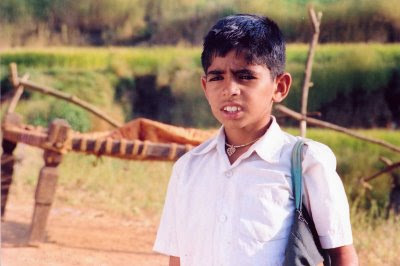.jpg)
Tingya is a 2008 Marathi-language movie. It is directorial début of Mangesh Hadawale. The movie is based on a life of a rural boy and his love and friendship with a bull. It concentrates on the hardships faced by the farmers in the state of Maharashtra, India. Tingya was nominated and have won numerous awards and was screened at the Pune International Film Festival and the 'Mumbai Academy of Movies Images'. (-From Wikipedia.org.)
I grew up watching Hindi movies in a small town in Assam. Yes, there was a Assamese movie industry which churned out movies once in a while. Most of them were superhits because it was the only occasion families would go to theatre to see a movie. Even I accompanied my family. I have nothing against the films per se, but the occasion was essentially family, hence boring. After I moved to Pune, it was the Hollywood staple of the blockbuster types. Slowly, I was introduced to the world cinema.
As I was moving towards world cinema, I was slowing moving away from the regional cinema, whatever language it may be. Sometimes, a friend gets a DVD and forces me to see it, it’s a classic. I saw a few Dada Konke movies (Still can’t figure out why he was so popular), and Shreeram Lagoo’s break-out ‘Pinjara’. I saw ‘Dombivli Fast’ at the insistence of the same friend, and can’t thank him enough for it. It was an experience of a lifetime. I could not sleep that night. What if, everyone of us snap one day like Madhav Apte and begin to take the law in their hands? It was a very disturbing thought. What happens when you stop believing in the system anymore?
Then last year, I saw ‘Valu’ and loved it. I thought it was beautiful piece of cinema, especially while recreating the village life which I am sure wouldn’t be there ten years from now. Therefore, when Tingya was playing at a film festival, I was not really interested. I assumed it would be melodramatic version of ‘Valu’. Now, that can be a put off. Instead, I went to see a Pedro Almadover film, which one I don’t even remember.
And I am sorry that I did not see ‘Tingya’ that day, and even after. I had denied myself an experience for so long.
Two days back, I got a few DVDs of Marathi films, including Chitra Palekar's 'Maatimai' and Vijay Tendulkar's ‘Sakharam Binder,’ and this time, I could refuse myself getting a copy of ‘Tingya’ as well. Everyone was talking about the film, let's see what it was about.
And, honestly, I loved the film. First because it's not a melodrama, which very well could have been. The screenplay may be little sloppy, but the newcomer Hadawale's direction is restrained. He would not tell you things in words if he can show them in visuals. Now, that's the first sign of a good director. On the DVD jacket, the director writes this is a story of a farmer who could be anywhere, in Assam or in Orissa. But the story Hadawale tells is essentially Maharashtrian, the emotions may be universal, but the landscape, the arid hills and the scattered hutments of the village is a typical Maharashtrian village. Picture perfect, until you scratch the surface. It's a world riddled with poverty and hardship. Yet, people cannot lose hope, life goes on.
Agreed, the film is tad long. Agreed, the focus keep shifting from Tingya to his father. Agreed, the melodrama still creeps in, the entire episode of Tingya going to town to call a doctor for his cow, but the film is built like pieces of dominoes, one piece after another, and that too in pairs. And that too in visuals, not words, it’s a work of art.
Early in the film, there is scene where Tingya and his father is crossing a bridge. It's a long shot. Then suddenly a young man in a skull cap passes-by in front of the camera. We are not even told the word Muslim, but we instantly know the village is equally populated by Hindus and Muslims. So, when Rashida is introduced, we trust her friendship with Tingya without reading too much into the communal harmony stuff.
At one point, when the cow falls ill, Tingya asks a question, even Rashida's grandmother is ill, and people came to visit her. Why no one comes to visit their cow? This innocent question form the crux of the film. If the other half can, why not this half. This is the contrast that keeps the film going: two households, Hindu and Muslim; the cow and the bull; the bull and the tractor; the woman and the cow; the pairs are endless.
The film ends with another haunting image, when Tingya celebrates with Rashida that a calf is born in his house, the camera panes and we see the pregnant belly of Rashida's mother. And we know, life thrives even in the most desperate situations.
Life-affirming.
— Dibyajyoti Sarma
No comments:
Post a Comment